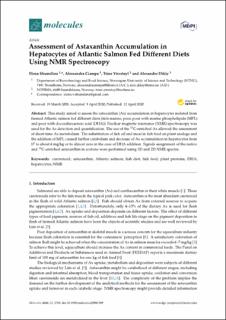| dc.contributor.author | Shumilina, Elena | |
| dc.contributor.author | Ciampa, Alessandra | |
| dc.contributor.author | Ytrestøyl, Trine | |
| dc.contributor.author | Dikiy, Alexander | |
| dc.date.accessioned | 2020-09-17T12:17:05Z | |
| dc.date.available | 2020-09-17T12:17:05Z | |
| dc.date.created | 2020-04-12T17:04:50Z | |
| dc.date.issued | 2020 | |
| dc.identifier.citation | Molecules. 2020, 25 (8), 1-9. | |
| dc.identifier.issn | 1420-3049 | |
| dc.identifier.uri | https://hdl.handle.net/11250/2678285 | |
| dc.description.abstract | This study aimed to assess the astaxanthin (Ax) accumulation in hepatocytes isolated from farmed Atlantic salmon fed different diets (rich marine, poor, poor with marine phospholipids (MPL) and poor with docosahexaenoic acid (DHA)). Nuclear magnetic resonance (NMR) spectroscopy was used for the Ax detection and quantification. The use of the 13C-enriched Ax allowed the assessment of short-time Ax metabolism. The substitution of fish oil and meal in fish feed on plant analogs and the addition of MPL caused further catabolism and decrease of Ax accumulation in hepatocytes from 17 to about 6 mg/kg or to almost zero in the case of DHA addition. Signals assignment of the native and 13C-enriched astaxanthin in acetone were performed using 1D and 2D NMR spectra. | |
| dc.language.iso | eng | |
| dc.title | Assessment of Astaxanthin Accumulation in Hepatocytes of Atlantic Salmon Fed Different Diets Using NMR Spectroscopy | |
| dc.type | Peer reviewed | |
| dc.type | Journal article | |
| dc.description.version | publishedVersion | |
| dc.source.pagenumber | 1-9 | |
| dc.source.volume | 25 | |
| dc.source.journal | Molecules | |
| dc.source.issue | 8 | |
| dc.identifier.doi | 10.3390/molecules25081769 | |
| dc.identifier.cristin | 1805921 | |
| dc.relation.project | Fiskeri- og havbruksnæringens forskningsfinansiering: 901271 | |
| dc.relation.project | EC/H2020/653706 | |
| cristin.ispublished | true | |
| cristin.fulltext | original | |
| cristin.qualitycode | 1 | |
